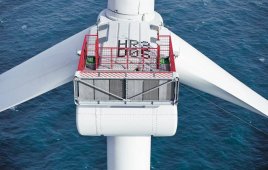Wally Lafferty and Paul Dvorak
Editor’s note: Mr. Lafferty and I published an earlier version of this editorial in the April issue of Windpower Engineering & Development. We now have the benefit of a more thorough financial review which is reflected in the dollar values here.
Critics of the Production Tax Credit cite a report from the Congressional Joint Committee on Taxation that claims the PTC costs the taxpayer $13.8 billion.
WHAT MOST PEOPLE DON’T KNOW is that this estimate was calculated — according to the Congressional Research Service — from the “foregone tax revenue” from wind farms that are currently receiving the benefit. In other words, this estimate was based on the assumption that wind farms would be paying more taxes if they were not benefiting from the PTC.
This is a completely false assumption and we are astonished that the American Wind Energy Association has not done more to refute the estimate. The truth is, had these wind farms not received the PTC, they would likely not have been built in the first place, as evidenced by the 92% drop in new wind farm starts since the PTC expired in 2013. Without the tax credit, no wind farms are being built to generate any tax revenue at all.
A sizable wind farm can produce up to $20 million in annual income, and owners do pay taxes on that income, albeit at a slightly reduced rate thanks to the PTC. Based on the effective tax rate that wind farms pay after receiving the PTC (est. average 15%), the IRS can receive as much as ($20 million x 15% PTC-reduced tax rate =) $3 million in tax revenue per year from a wind farm.
AWEA figures from 1999 to 2014 show that the years 1999, 2001, 2003, and 2012 were good growth years in the wind industry. The PTC expired at the end of each of these years and construction in the following years plunged on average 83.5%. Last year was also a good year with some 12,700 MW under construction. As it looks now, (12,700 MW x 0.835 average drop in construction =) 10,604 MW of wind capacity will not begin construction in 2015. Assuming an average of 2 MW/turbine we find that (10,604 total MW / 2 MW per turbine =) 5,302 turbines will not be installed.
A wind turbine can generate $735,000 in annual revenue. At an estimated tax rate of 15%, that equates to some $110,250 of income tax paid to the IRS per turbine per year. Multiply that by the number of turbines not built in 2015, and the IRS is losing ($110,250 tax revenue x 5,302 turbines not built =) $584.5 million per year in foregone tax revenue. If this loss continues over the 20-year life expectancy of each wind turbine, the IRS could lose $11.7 billion over 20 years for the turbines that were not built in 2015.
AWEA reports that wind turbines account for 70% of a wind farm’s cost and 30% goes to construction. At $2 million in total cost per MW, it costs roughly $600k per MW to construct a wind farm. That means (10,604 MW not constructed in 2015 x $600k construction cost =) $6.4 billion will not be spent in taxable construction projects and its taxable jobs in 2015. It’s also important to consider that taxable investments would otherwise have been made by private companies.
This sad revelation gets even sadder when you consider the taxable land-lease payments not made and the taxable jobs not generated. For instance, the Global Wind Energy Council reports that a farmer in Iowa who leases one tenth of a hectare for a wind turbine could earn about 10,000 taxable dollars per year compared to about $300 using the same area to grow corn for ethanol. That means 5,302 unbuilt turbines will not provide $10,000 each in annual leases. That means there are $53 million not paid to land owners who will not be paying federal income taxes on those lease payments. Never mind the local taxes not paid to rural communities, their schools, and fire and rescue departments.
And the jobs? The Renewable Energy Policy Project estimates that every 1 MW of installed capacity creates about 4.8 job-years of employment, including both direct (construction and operations) and indirect (office support) labor. So the 10,604 MW that will not be built in 2015 would have created (10,604 MW x 4.8 job-years =) 50,899 taxable job-years of employment. With the expiration of the PTC, that work is not there and that income tax will not be paid.
There are even more sources of foregone tax revenue, but you get the point by now. Every one of these wind-related costs would have generated more tax revenue for the government — tax revenue that is not going to be created because the PTC has expired. The PTC isn’t a subsidy. It’s not even fair to refer to the PTC simply as a tax credit. It’s a considerable tax revenue generator.
Filed Under: Financing




